Have you ever wondered how to elevate your garden recipes and add a touch of beauty and flavor? Look no further than incorporating edible flowers into your dishes. Edible flowers not only bring vibrant colors to your plate but also impart subtle floral notes that can transform even the simplest of recipes. Discover the art of using edible flowers in your garden recipes and unleash a world of creativity and deliciousness into your culinary repertoire. From savory salads to delightful desserts, the possibilities are endless when you embrace the natural beauty of edible flowers in your cooking.

Choosing Edible Flowers
Understanding Edible Flowers
Before choosing edible flowers for your garden, it’s important to understand what exactly makes a flower edible. Edible flowers are safe for human consumption and can add both flavor and visual appeal to a wide range of dishes. However, not all flowers are safe to eat, and some can even be toxic. Researching different types of edible flowers and their characteristics is essential to ensure a positive and safe experience.
Researching Edible Flowers
Now that you have a basic understanding of what makes a flower edible, it’s time to dive deeper into researching various types of edible flowers. Look for flowers that are commonly used in culinary applications and are known to be safe for consumption. Some popular choices include pansies, nasturtiums, violets, and marigolds. As you research, make note of their flavors, colors, and any specific qualities they may have, such as a spicy or peppery taste or vibrant colors.
Considering Taste and Aroma
When selecting edible flowers, it’s important to consider both their taste and aroma. Different flowers have different flavors, ranging from sweet to tangy to spicy. Think about the dishes you plan to incorporate the flowers into and choose flowers that will complement the flavors of those dishes. Additionally, the aroma of the flowers can greatly enhance the overall sensory experience, so take into account how the fragrance will interact with the flavors of your recipes.
Checking for Allergies
Before diving into edible flower gardening, it’s crucial to check for any allergies you or your loved ones may have. While edible flowers are generally safe for consumption, some individuals may have specific allergies to certain types of flowers. It’s always a good idea to consult with medical professionals or conduct allergy tests to ensure a safe experience. Keep in mind that allergies can vary, so it’s essential to consider any potential risks before incorporating edible flowers into your diet.
Preparing Your Garden
Choosing an Appropriate Location
When preparing your garden for edible flowers, choosing the right location is key. Most edible flowers thrive in full sun, so look for an area in your garden that receives at least 6 hours of direct sunlight each day. Ensure that the location has well-draining soil and is protected from strong winds, as this can affect the growth and health of your edible flowers.
Preparing the Soil
Properly preparing the soil is crucial for the success of your edible flower garden. Loosen the soil to ensure good drainage and remove any weeds or grass. Adding organic matter such as compost or well-rotted manure will help improve the soil’s fertility and provide essential nutrients for your flowers. Consider conducting a soil test to determine if any specific amendments are needed to achieve the ideal pH and nutrient levels for edible flowers.
Selecting Edible Flower Varieties
Now that your garden location and soil are prepared, it’s time to choose the specific varieties of edible flowers you want to grow. Consider the flavors and colors you’re looking to add to your recipes and select a variety of edible flowers to suit your preferences. Planting a diverse selection will not only add visual interest to your garden but also provide a wider range of flavors and aromas to experiment with in your culinary creations.
Planning Your Garden Layout
Before planting your edible flowers, take some time to plan out your garden layout. Consider the heights, growth habits, and spacing requirements of your chosen flowers to ensure they have enough room to grow and thrive. Additionally, think about how the flowers will complement each other visually. Grouping flowers with similar colors or contrasting them for a dynamic visual impact can create a stunning garden display.
Planting Edible Flowers
Sowing Seeds
One method of planting edible flowers is to sow seeds directly into the garden. Follow the instructions on the seed packets for the recommended planting depth and spacing. Prepare the soil by removing any debris and gently rake the surface. Sprinkle the seeds evenly and cover them lightly with soil. Water the area gently, keeping the soil consistently moist until the seeds germinate.
Transplanting Seedlings
Another way to start your edible flower garden is by purchasing seedlings from a local nursery or starting them indoors and transplanting them later. If you choose to transplant seedlings, wait until the risk of frost has passed and the soil has warmed up. Dig a hole that is slightly wider and deeper than the seedling’s root ball, gently place the seedling in the hole, and backfill with soil. Water thoroughly to help the roots establish.
Dividing and Propagating
Once your edible flowers have matured, you may consider dividing and propagating them to expand your garden. Some flowers, such as chives or mint, can be divided and transplanted to create new plants. Carefully dig up the mature plant and divide it into smaller sections, ensuring each section has roots attached. Replant the divisions in prepared soil, water well, and provide proper care to encourage healthy growth.
Caring for Edible Flowers
Proper care is essential to ensure the health and vitality of your edible flowers. Regular watering, taking care not to overwater or underwater, is crucial for their survival. Applying organic mulch around the plants can help retain moisture and suppress weeds. Monitor your garden for pests and diseases, and take appropriate measures to control any issues that arise. Fertilize your edible flowers periodically using organic fertilizers to provide them with the necessary nutrients for optimal growth.
Harvesting and Storing Edible Flowers
Determining When to Harvest
Knowing the right time to harvest your edible flowers is important to achieve optimal flavor and freshness. Each type of flower has its own timeline for maturity, so familiarize yourself with the specific harvesting guidelines for each variety you’re growing. Generally, flowers are best harvested in the morning when they are at their peak freshness. Look for flowers that have fully opened but have not yet begun to wilt or fade.
Harvesting Methods
When harvesting edible flowers, it’s important to use gentle methods to preserve their delicate petals. Using clean garden shears or scissors, carefully cut the flower stems close to the base of the plant. Handle the flowers with care to avoid bruising or damaging them. Avoid harvesting during or immediately after rainfall, as the excess moisture can affect the flavor and texture of the flowers.
Properly Handling Edible Flowers
To maintain the quality of your harvested edible flowers, proper handling is crucial. Immediately after harvesting, gently wash the flowers under cool running water to remove any dirt or debris. Carefully pat them dry with a clean cloth or paper towel. It’s important to handle the flowers gently to avoid bruising or wilting. If you’re not using the flowers immediately, store them in a cool, dark place until you’re ready to use them.
Best Storage Practices
To extend the shelf life of your harvested flowers, it’s essential to store them properly. Place the flowers in airtight containers or ziplock bags lined with a damp paper towel to help maintain their moisture. Store them in the refrigerator, preferably in the crisper drawer, where the humidity is higher. Check the flowers periodically and remove any wilted or spoiled blossoms to ensure the freshness and quality of the remaining ones.

Edible Flower Recipe Ideas
Floral Infused Drinks
Incorporating edible flowers into your beverages can create refreshing and visually appealing drinks. Whether you’re making infused waters, floral iced teas, or floral lemonades, adding edible flowers can elevate the flavor and add a touch of elegance to your beverages. Experiment with different combinations of flowers and herbs to create unique and delicious floral-infused drinks.
Savory Flower Salads
Edible flowers can add a vibrant and flavorful element to your salads. Try adding nasturtiums, borage flowers, or pansies to your favorite salad greens for a burst of color and peppery flavor. Edible flowers not only enhance the visual appeal of your salad but also provide an array of flavors that can complement various dressings and ingredients.
Flower Petal Jams and Preserves
Using flower petals to make jams and preserves can give your homemade spreads a unique twist. Edible flowers like roses, lavender, or violets can infuse your jams with delicate floral flavors. Make sure to use only the petals, removing the bitter white base before adding them to your recipe. Spread these floral jams on toast, scones, or pancakes for a delightful breakfast or afternoon treat.
Edible Flower Garnishes
Garnishing your dishes with edible flowers can instantly elevate their presentation and add a touch of sophistication. Place a few flowers on top of soups, risottos, or pasta dishes to create a visually striking presentation. Edible flowers can also be used as colorful accents on cheese platters or to decorate cakes and desserts, making them truly stand out.
Edible Flowers for Baking
Adding Flowers to Breads and Pastries
Incorporating edible flowers into your baked goods can add an artistic touch and unique flavors. Add colorful petals or whole flowers to bread doughs or pastry crusts for a stunning visual effect. Roses, calendulas, and pansies are popular choices for adding floral flair to breads, muffins, and other baked treats.
Decorating Cakes and Cupcakes
Beautifully decorated cakes and cupcakes can be taken to the next level by using edible flowers as decorations. Whether you choose to place whole flowers on top of your frosted creations or create intricate designs with petals, edible flowers can transform plain desserts into stunning masterpieces. Consider using edible flowers like violets, marigolds, or chamomile for their vibrant colors and contrasting shapes.
Floral Flavored Desserts
Floral flavors can add a unique twist to your desserts. Infuse your custards, puddings, or ice creams with floral essence by steeping edible flowers in milk or cream before incorporating them into your recipes. Lavender, elderflower, and jasmine are just a few examples of flowers that can impart their delicate flavors in desserts.
Using Edible Flowers in Icing
Taking your icing to the next level by incorporating edible flowers can create intricate and visually stunning designs. Edible flowers can be pressed onto a layer of freshly applied icing or carefully arranged on top of the cake to create a beautiful edible centerpiece. Experiment with different flowers and colors to create unique designs that will impress your guests.

Edible Flowers in Main Courses
Edible Flowers in Stir-Fries
Adding edible flowers to stir-fries can bring freshness and a burst of color to your dishes. Flowers like daylilies, chives, or squash blossoms are excellent choices for stir-fries, as they can withstand the heat and retain their vibrant colors. Toss them in towards the end of cooking to preserve their delicate flavors and textures.
Flower-Inspired Soups
Edible flowers can add visual interest and unique flavors to soups. Whether you add whole flowers as a garnish or incorporate the petals into the broth, edible flowers can transform a simple soup into an impressive culinary creation. Consider using flowers like nasturtiums, pansies, or dandelions to add a touch of elegance to your soups.
Floral Pizza Toppings
Get creative with your pizza toppings by adding edible flowers for a unique twist. Flowers like arugula blossoms, basil flowers, or chive blossoms can add a hint of floral flavor to your pizzas. Simply sprinkle the flowers on top after the pizza is baked to preserve their delicate nature.
Creative Flower Pasta Dishes
Edible flowers can be used to create visually stunning and delicious pasta dishes. Toss cooked pasta with edible flowers like squash blossoms, violets, or chive blossoms for a vibrant and flavorful meal. Edible flowers can also be used as a garnish to add a pop of color to your pasta plates.
Edible Flower Tips and Tricks
Edible Flowers to Avoid
While many flowers are safe to eat, there are certain flowers that should be avoided. Some flowers, like daffodils, morning glories, or lily of the valley, are toxic and should never be consumed. It’s essential to thoroughly research the flowers you plan to use and ensure they are safe for consumption before incorporating them into your recipes.
Edible Flower Pairings
Experimenting with different flavor pairings can take your edible flower creations to the next level. Consider pairing delicate flowers like lavender or chamomile with light and fruity flavors, while more robust flowers like marigolds or nasturtiums can be paired with tangy or spicy ingredients. Play around with different combinations to discover your favorite flavor pairings.
Tips for Using Edible Flowers
When using edible flowers, it’s important to keep a few tips in mind. Harvest flowers in the morning when they are at their freshest, and handle them gently to avoid bruising or wilting. Use only the petals of the flowers, removing the bitter parts. Introduce the flowers gradually in your recipes to determine the desired flavor intensity. Remember that a little goes a long way when it comes to using edible flowers.
Preserving the Beauty and Flavor
To preserve the beauty and flavor of your edible flowers, there are a few techniques you can use. Infusing flowers in oil, sugar, or vinegar can help capture their essence for future use. Drying flowers is another method that allows you to preserve their colors and flavors for an extended period. Whichever method you choose, store the preserved flowers in airtight containers in a cool, dark place to maintain their quality.

Edible Flower Safety Guidelines
Know Which Flowers are Edible
Before incorporating flowers into your diet, it’s crucial to know which flowers are safe to eat and which should be avoided. Educate yourself about different types of edible flowers and their characteristics to ensure a safe culinary experience. Familiarize yourself with flowers that are toxic or may cause allergies to avoid any potential health risks.
Avoid Using Pesticides or Chemicals
When growing edible flowers, it’s important to avoid using pesticides or chemicals that may be harmful when consumed. Opt for organic and natural pest control methods to protect your plants from pests and diseases. Regularly inspect your plants for signs of damage or infestation and take appropriate measures to address any issues using safe and environmentally-friendly methods.
Avoid Flowers Near Roadways or Pollution
When choosing a location for your edible flower garden, it’s best to avoid areas near roadways or places where pollution is prominent. Flowers have the ability to absorb pollutants from the air and soil, so planting them in clean and pollution-free environments is essential. This will help ensure that the flowers you harvest are safe for consumption and free from any harmful substances.
Check for Possible Allergies
Before incorporating edible flowers into your diet, it’s important to check for any possible allergies you may have. Some individuals may have allergies to specific flowers, so it’s always a good idea to consult with medical professionals or conduct allergy tests if you have any concerns. By identifying potential allergens, you can enjoy edible flowers in a safe and worry-free manner.
Sharing Your Edible Flower Creations
Hosting Flower-Themed Gatherings
Once you have mastered the art of incorporating edible flowers into your garden recipes, why not showcase your creations by hosting a flower-themed gathering? Invite friends and family over and prepare a spread of dishes that feature edible flowers. Create a visually stunning table setting with floral centerpieces and encourage your guests to indulge in the beauty and flavors of your edible flower dishes.
Sharing Recipes with Friends
If your friends and family are intrigued by your edible flower recipes, consider sharing your knowledge and recipes with them. Host a cooking or baking workshop where you can teach them how to incorporate edible flowers into their own recipes. Share tips and tricks you have learned along the way and inspire others to explore the world of edible flowers.
Giving Edible Flower Gifts
Surprise your loved ones with unique and thoughtful gifts by incorporating edible flowers into homemade treats. Create personalized flower-infused jams or infused oils, and package them in decorative jars with a handwritten recipe card. Presenting these edible flower gifts will not only showcase your culinary skills but also spread joy and appreciation for the beauty and flavors of these blossoms.
Contributing to Community Events
Consider contributing your edible flower creations to community events or local fundraisers. Showcase your culinary skills and introduce others to the world of edible flowers by providing a taste of your delicious creations. This allows you to share your passion for edible flowers with a wider audience while supporting local initiatives and organizations.
By following these comprehensive guidelines, you’ll be well-prepared to dive into the world of edible flowers. From understanding the characteristics of edible flowers to properly caring for your garden and incorporating these beautiful blossoms into a variety of recipes, you’ll be on your way to creating stunning and delicious dishes that will impress both your taste buds and your guests. So get ready to embark on a culinary adventure filled with color, aroma, and the delightful flavors of edible flowers!


